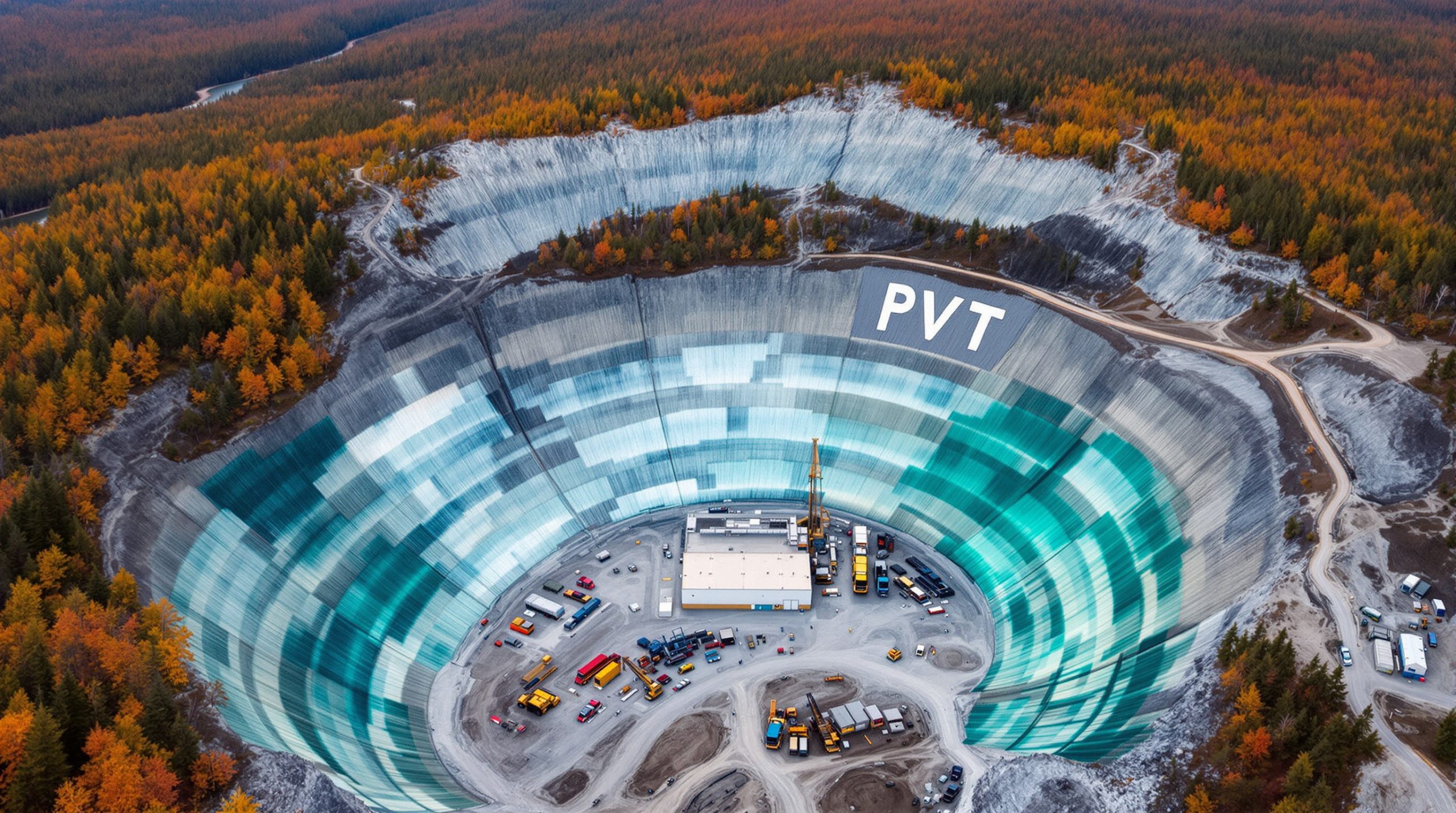North Stawell Minerals Set to Target High-Grade Gold Discovery at Darlington
North Stawell Minerals (ASX:NSM) is preparing to launch a significant diamond drilling program in mid-September to follow up on an exceptional high-grade gold discovery at Darlington Prospect in Western Victoria. The drilling will target extensions of a recently discovered brecciated quartz-sulphide vein that yielded 2.3m at 29.2 g/t gold, including an impressive 0.8m at 82.3 g/t gold.
This high-grade gold discovery at Darlington represents a compelling opportunity for the company as it seeks to expand its footprint in this historically productive gold region. The intercept's exceptional grade has generated significant interest among investors and industry analysts alike.
Targeting a Potential New High-Grade Gold System
The upcoming drilling program will focus on the area surrounding drill hole NSD057, which intercepted visible gold in a brecciated quartz-sulphide vein at relatively shallow depths (108.2-110.5m). What makes this high-grade gold discovery at Darlington particularly compelling is that it's "off-trend" from previous gold intercepts at Darlington and remains open in all directions.
Historical production from the nearby Darlington Mine, located just 200 metres north of the target, further validates the potential, having produced 2,347 ounces of gold at an average grade of 18.2 g/t. This production history supports the company's interpretation that the area may host a significant high-grade gold system.
The drilling campaign, expected to total between 600-900 metres, is designed to determine the extent and orientation of this newly discovered mineralisation. Assay results are anticipated by late October or early November, weather and operational factors permitting.
The "Mariners-Style" Gold Potential
What has investors particularly excited is the geological similarity between the Darlington Prospect and the historic "Mariners-style" gold deposits at Stawell. The high-grade gold discovery at Darlington shares key characteristics with these historic mines, including:
- Similar high-grade gold values
- Comparable structural setting
- Matching geology and mineralisation style
- Positioning above a deeper basalt dome
The historic Mariners Mines represent an important exploration model for the company. These mines, which operated between 1856 and 1880, featured multiple shafts along a 1,100-metre trend reaching depths of up to 500 metres.
Most notably, they produced at an average grade of 28-30 g/t gold, with total historical production estimated between 780,000-950,000 ounces of gold.
This history demonstrates that large, high-grade gold systems can exist in the Stawell Corridor, providing a compelling template for North Stawell's exploration at Darlington.
Part of a Larger Mineral System
Darlington may be just one part of a more extensive gold system occurring above the northern continuation of the same basalt that hosts the Stawell Gold Mine. The company has identified a 5.5km strike extent of this prospective basalt within NSM tenements.
The Caledonia Prospect, located 2km north of Darlington, shows similar geological, structural, and mineralisation characteristics, suggesting a potentially extensive gold-bearing corridor.
Furthermore, additional basaltic structures have been identified further north at the Wildwood Prospect and Lubeck Tip Prospect, 20km north of Stawell.
Understanding Stawell-Type vs. Mariners-Type Gold
Geological Distinctions
For investors new to Victorian gold geology, understanding the difference between "Stawell-type" and "Mariners-type" mineralisation provides crucial context:
Stawell-type mineralisation: Gold deposits form on the margins of basaltic domes, as seen at the Stawell Gold Mine which has produced over 5 million ounces. The mineralisation follows the contours of the basalt where it interacts with surrounding sedimentary rocks.
Mariners-type mineralisation: This style features structurally controlled splays of mineralisation occurring in sedimentary rocks above a deeper basalt. The mineralisation typically consists of brecciated, faulted quartz veins with visible gold and high grades.
The high-grade intercept at Darlington appears to be Mariners-type mineralisation, potentially sitting above a deeper basaltic structure. This is particularly significant because it suggests the possibility of a substantial gold system similar to the historically productive Mariners mines.
Exploration Advantages in the Stawell Corridor
North Stawell Minerals holds a strategic 504 km² contiguous tenement package covering the gold-prospective corridor north of Stawell Gold Mine. Over 80% of this ground is covered by a thin blanket of unmineralised sediment, which has historically limited exploration but also preserved potential for large, near-surface gold deposits.
The company's exploration approach leverages modern geophysical techniques to detect basaltic domes beneath this cover—a key advantage since these domes are intrinsically associated with Stawell-type mineralisation and can be identified through geophysical signatures.
"The recent high-grade gold discovery at Darlington represents a significant opportunity for North Stawell Minerals. The geological similarities to the historic Mariners gold system are particularly encouraging and support our exploration model for the Stawell Corridor," stated the company's Head of Exploration.
Upcoming Catalysts for Investors
The upcoming drilling program represents a significant catalyst for North Stawell Minerals. With drilling scheduled to commence in the second half of September, investors can anticipate:
- Initial drilling updates and observations
- Assay results expected by late October/early November
- Potential resource definition if the mineralisation proves extensive
- Follow-up exploration programs based on results
The company's strategic position in the Stawell Corridor, combined with the high-grade nature of the initial gold discovery at Darlington, presents a compelling opportunity for investors interested in Australian gold exploration.
Why Follow North Stawell Minerals
North Stawell Minerals offers investors exposure to a focused, high-potential gold exploration company with several compelling advantages:
-
High-Grade Discovery Potential: The recent intercept of 2.3m at 29.2 g/t gold indicates the possibility of a significant high-grade gold system.
-
Strategic Location: The company's tenements extend along the same geological structures that host the multi-million-ounce Stawell Gold Mine.
-
Proven Mining District: The Stawell Gold Corridor has produced over 5 million ounces historically, demonstrating the region's gold endowment.
-
Systematic Exploration Approach: The company is applying modern exploration techniques to detect mineralisation beneath shallow cover that has historically limited exploration.
-
Near-Term Catalysts: With drilling about to commence and results expected within months, there are clear upcoming value inflection points.
Educational Section: Victoria's Gold Mineralisation Systems
Historical Context and Geological Significance
Victoria has a rich history of gold production, with different mineralisation styles producing some of Australia's most significant gold deposits. The high-grade gold discovery at Darlington represents an important example of the Mariners-style mineralisation, which differs from the more common Stawell-type deposits.
In the Stawell-type deposits, gold mineralisation occurs primarily at the margins of basaltic domes, with gold deposited where the basalt contacts surrounding sedimentary rocks. These deposits can be quite large, as evidenced by the 5 million ounces produced at the Stawell Gold Mine.
By contrast, Mariners-type mineralisation, which appears to be the style at Darlington, consists of structurally controlled veins and breccias in sedimentary rocks above a deeper basalt. These deposits can be exceptionally high-grade, often containing visible gold and producing at grades of 20-30 g/t gold or higher.
Both styles of mineralisation are part of the broader category of orogenic gold deposits, formed during periods of mountain building when gold-bearing fluids moved along faults and structures created by tectonic activity. This geological setting has made Victoria one of Australia's premier gold provinces, with historical production exceeding 80 million ounces.
As North Stawell Minerals advances its exploration at Darlington, the company is well-positioned to potentially unlock another chapter in Victoria's gold mining story, targeting a mineralisation style proven to host substantial high-grade gold deposits in the region.
Investment Opportunity Summary
As drilling at Darlington gets underway, North Stawell Minerals represents an opportunity to invest in a gold explorer with high-grade discovery potential in one of Australia's most productive gold provinces. The company's systematic approach to testing the northern extension of the Stawell Gold Corridor could unlock significant value if drilling confirms the extent of this newly discovered high-grade gold system.
Moreover, the high-grade gold discovery at Darlington could be just the beginning of a series of discoveries along this highly prospective corridor, potentially establishing North Stawell Minerals as a significant player in Victoria's resurgent gold sector.
Ready to Capture Early Returns on the Next Major Gold Discovery?
Stay ahead of the market with real-time alerts on significant ASX mineral discoveries like North Stawell's high-grade gold find, powered by Discovery Alert's proprietary Discovery IQ model—visit our discoveries page to understand how early investors in major mineral discoveries have historically achieved substantial returns.




